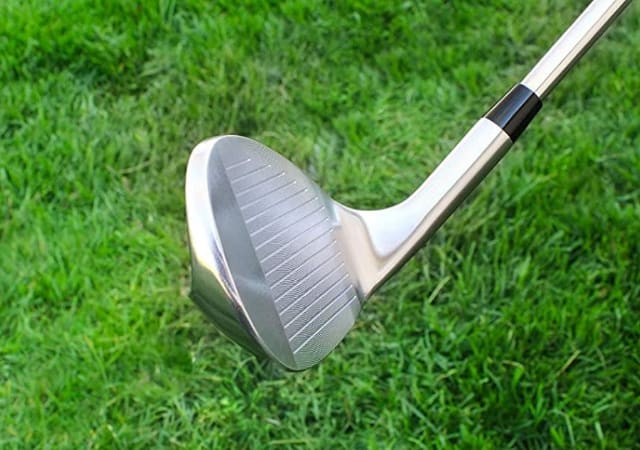Bunker shots are among the most challenging in golf. Getting the ball out of the sand needs a different technique than any other stroke in the game. Combine this with the fact that each type of sand is unique, and you’ve got a formula for a challenging up-and-down.
A few aspects of the game divide professionals and amateurs as much as sand. The average tour professional views a regular bunker shot as a reasonably simple up and down, if not an opportunity to hole out. The casual golfer’s only concern is getting the ball out in one stroke without sending it sailing over the green.
In this article, we provide pro tips on how to hit out of a bunker and give answers to the most frequently asked questions related to the topic.
4 Steps to Hit a Bunker Shot

A bunker shot requires you to have a flat clubface, a broad and open stance, positioning the ball inside your lead foot, placing 80 percent of your weight on that leg, cocking the wrists early in the takeaway, and swinging quickly while keeping the club face skyward. You should also slap the sand just behind your ball and allow the club to exit left on this shot.
Step 1: Choose the Right Club

If you find yourself short-sided in a greenside bunker (meaning you have a small area of green to work with), you want to choose a lofted wedge, such as a 60-degree lob wedge. The ball will be less likely to roll out as much.
A 56-degree sand wedge or gap wedge (around 52 degrees) is your best choice if you have some green in play. This will result in a somewhat longer ball flight out of the trap. Simply because one wedge is labeled “sand wedge” does not mean that it is the only club you can use while hitting out of a greenside bunker.
You May Also Like: Best 56-Degree Wedges – Reviews & Buying Guide
Step 2: Take the Right Setup
The proper setup is critical for an efficient shot from the bunker. To begin, dig your heels into the sand. Apart from establishing a solid foundation for the shot, which is critical, you get a sense of how deep the sand is around your target.
For most sand shots, you want to play the ball off your front foot. The further back you move the ball, the lower its trajectory and the more it will run out. While this can be advantageous for certain shots, play the ball off your front foot as a general rule. Bear in mind that this is not a pitch-and-run situation. Backspin will be applied to the shot.

Following that, open your stance and clubface. This is critical. This results in a higher, softer ball flight and allows the clubface to slip under the ball at an optimal angle.
Finally, your weight should be distributed between your front and back feet. The weight distribution should be approximately 80%-20% in favor of the front foot. This is critical because it results in a steep descent, which produces the splash of sand (the digging) and backspin associated with a solid bunker shot.
Acceleration is the first swing concept to consider while learning to hit a bunker shot properly. When hitting bunker shots, the world’s finest golfers generate speed.
When a player’s foot leaves the gas pedal, a par save becomes a bogey mistake or worse. Why? Because your objective is to make contact with the sand, not the ball. Yes, the ball is carried out of the bunker by the sand. Thus, the optimum pace is crucial.
Step 3: The Swing

Once you’ve dug in, with the ball forward in your stance, your weight on your front foot, and your stance and clubface slightly open, the time has come to pull the trigger.
You want a swing path that is outside-in with a minimal wrist hinge at the top. How far back you place the ball is determined by how far you want it to fly. With this swing path, the ball comes out softly and with the maximum amount of control. It will take you some practice to judge the yardage accurately until it feels natural.
Step 4: The Follow-Through

A sharp angle of attack is required for a shot from the bunker, and aggressively hinging your wrists is a fantastic method to achieve it. It’s best to aim for the sand behind the ball when you begin your downswing. Try to hit the ball in that position and allow the club to glide underneath the ball through the sand as you hit it. When you hit sand into the bunker, the ball should explode out of it and land safely on the green.
Sand shots necessitate more patience and persistence on your part. Delaying or stopping at the point of impact will cause it to shatter. Splashing the ball out of a greenside bunker necessitates a steep swing and a high follow-through.
You’ll catch the shot thin and blade it if you approach it too quickly. Taking sand with the shot doesn’t mean that you have to be frightened to swing a little more aggressively. It won’t go as far as you think.
To progress to the next level, you’ll need to get a little more technical with your greenside sand shots. Sand shots of medium length and plugged balls are two common sand shots encountered on the course. Although they are two of the most difficult shots in golf, don’t let your fear of them hold you back. Except for a few slight variations, they’re playing just like standard greenside shots.
For a more comprehensive guide, you may refer to this video (3 minutes 3 seconds) by Golf.com.
Additional Tips
Greenside sand shots appear to create anxiety in many people, and we can sympathize. The diversity of different types of terrible shots varies considerably, from hardly advancing the ball to thinning it to the point of crying “fore” at golfers on the green.
This diversity is one of the reasons why so many golfers are afraid of these shots. Take a refresher on how to play golf to establish a solid foundation then continue to learn how to make bunker shots.
Here are several things you must grasp and apply to transform your bunker game into a weapon in your armory and improve your consistency.
1. Practice Drills

Drills are an excellent approach to maximize your practice time and develop real-world skills that you can apply on the course. Additionally, effective drills can help develop a player’s confidence by being capable of amplifying them to success. Any golfer who wants to improve their game gradually over time should keep a list of drills on hand to keep things going in the right direction during practice.
Drill 1: Draw Lines and Fine-Tune Your Distance Perception
Drawing lines in the sand behind your ball is an easy method to improve your control over bunker shots. This provides a visual indication of where you should strike the sand to make the ball airborne.
Begin by drawing a line an inch behind your ball and aiming to make contact with it with each swing – experiment with adjusting how open or closed your clubface is, as this can alter the ball’s flight trajectory and result in higher or lower shots.
After a few balls are struck, clear the sand and redraw the line — this time two inches behind the ball. Because you’re taking more sand with this approach, you’ll need to swing harder to get the ball out of the bunker, which is an excellent method to get a feel for the length of swing necessary to get the ball airborne in this circumstance.
Practice hitting these shots from both the center of the bunker and closer to the lip, as this will show you how open or closed the clubface needs to be to achieve the desired result.
Drill 2: Bunker Rounds Fired in Rapid Succession
Anxiety is the main reason that keeps amateur players from becoming good bunker hitters — they worry about the outcome, which results in stress and, ironically, the awful shot they feared in the first place.
A simple drill that reduces tension in your arms and hands and lets you play freely is an excellent approach to alleviate this stress.
Lay up to ten golf balls in the center of the bunker approximately two inches apart and draw a straight line approximately one inch behind them. The objective is to strike all ten balls (line first) consecutively within ten seconds without pausing your swing.
Swinging freely in this manner – while still adhering to the core stages outlined previously in this article – can alleviate unnecessary strain and assist you in developing a fluid, effortless movement that will contribute significantly to your bunker play improvement.
2. Experiment with Throwing Sand onto The Green
To be a successful greenside sand player, you must be willing to take sand, and a lot of it. The club should enter the sand behind the ball, move across it, and emerge well after it.
This scraping motion allows the club’s loft to lift the ball. You do not have to attempt to lift the ball from the sand. Practicing throwing sand out of the bunker and onto the grass with your sand wedge is an excellent method to develop this proper action.
Acquiring proficiency in hitting sand will assist you in avoiding the skulled shot, in which the ball flies or snags the lip and returns to you. Additionally, it may be beneficial to learn that the loft of your sand wedge is sufficient to clear the majority of bunker lips. You are not required to do anything special except collect the sand and allow the loft to do the lifting.
3. Understand Your Release
Your bunker swing should be considerably more similar to your pitching swing than your full swing since it is critical to avoid the club shaft leaning too far toward the target for your club to glide rather than dig. And while it begins with a proper setup, it continues with a proper release that allows the club head to align with the shaft at impact.
This sensation is similar to your trail hand “slapping” the bottom of the club to allow the bounce to function correctly while preserving or enhancing the loft. If you can achieve the right bunker release, the club will glide through the sand because of the lofted face.
4. Bear in Mind the Golden Rule when It Comes to Fairway Bunkers
When you require additional distance out of a bunker, you should adjust your setup and technique to aid in making contact with the ball before the sand. Priority one is to choose a club with sufficient loft to clear the lip of the bunker in front of you.
More details on that below!
5. The Secret Is in The Splash
Phil Mickelson possesses excellent sand technique due to his long and smooth full swing. When exceptional bunker players — and Phil is one of the all-time greats — execute a long, smooth action with a lot of zipping at the bottom, you can see why.

Phil’s natural swing is long and flowing, which makes him an expert on the sand. However, there is no reason why you should not be able to make excellent bunker shots as well. Simply swing normally and strike the sand rather than the ball.
In your stance, place the ball slightly forward of center and favor your front foot. Hover the clubhead approximately two inches behind the ball—the point at which you wish to enter the sand. Slightly open the clubface to benefit from the bounce feature on the bottom of your sand wedge. Then imagine strewing sand and the ball onto the green. Allow no negative thoughts to enter. Position your swing for more control, thump the sand, and posture for the finale.
Know more of Phil’s secrets in this video (7 minutes 47 seconds) from Golf Tips Edit.
What Is the Best Club to Use out Of a Bunker?
The best clubs to utilize in bunkers are lofted wedges with a low bounce, such as a 56 or 60-degree wedge.
The increased loft will assist in elevating the ball more quickly, while the low bounce – preferably less than 8 degrees – will allow the club’s leading edge to cut through the sand more easily and prevent it from colliding with the back of the ball.

The additional loft allows laying the club wide open, increasing the chances of easily popping the ball out, while the low bounce allows the club to glide through the sand rather than strike the firm surface and result in the dreaded thin shot.
If the sand is very firm or moist, we’d recommend slightly tightening the clubface to reduce the likelihood of the clubhead rebounding off the ground and into the rear of the ball. Some would only use a wedge with less loft and greater bounce — for example, a 52 or 56-degree wedge with 12 degrees of bounce – in rather fluffy sand or while attempting to play a longer bunker shot.
In these instances, the added bounce reduces the likelihood of the club gliding directly under the ball and leaving it in the trap, while the decreased loft lowers the flight trajectory and adds distance. It is critical to evaluate the condition of the bunker sand, your lie, and the club that will give you the best chance of success.
Naturally, this advice only applies to greenside bunker shots or traps located within 30 yards of the putting surface.
Fairway Bunkers vs. Greenside Bunkers
Fairway Bunkers are located farther down the fairway, away from the green, and are typically shallower than greenside bunkers. They are designed to challenge you on your approach shots.
On the other hand, Greenside Bunkers are situated close to the putting green and are deeper, with steeper faces. Their main purpose is to test a golfer’s ability to escape tricky situations near the green.
Hitting from Fairway Bunkers
To successfully hit the ball out of a fairway bunker, use a slightly wider stance and position the ball slightly back in your stance, closer to your back foot. This setup helps you strike the ball before the sand. Take a controlled three-quarter swing, focusing on making ball-first contact.
Avoid digging into the sand; instead, aim to sweep the ball cleanly. Keep your body and head steady throughout the swing, and resist the urge to lift the ball too forcefully. The goal is to advance the ball as close to the green as possible with a consistent strike.
Hitting from Greenside Bunkers
When facing a greenside bunker shot, use a narrower stance and open the clubface slightly to increase loft. Position the ball slightly forward in your stance, toward your front foot. Dig your feet into the sand for stability. Adopt an open stance, aiming left of the target. Focus on hitting the sand, not the ball.
Swing the club along your body’s line while accelerating through the impact zone. The sand will lift the ball softly onto the green. Finish the swing with the clubface pointing toward the target. Remember, it’s crucial to maintain a consistent, smooth tempo and not rush the shot.
How Do You Hit out Of Hard Bunker Sand?
Hitting out of hard bunker sand is identical to hitting out of soft bunker sand, except that you should close the clubface more and position the ball in the center of your stance. By altering these setup circumstances, the club will strike the sand further downward and avoid bouncing into the rear of the ball.
Thin shots are one of the worst but most usual outcomes of hitting out of firm bunker sand, as they tend to fly directly across the green and into dangerous situations. They frequently occur because many players use hard sand the same way they do regular sand, believing they can lay the clubface wide open and pop the ball out.
In contrast, a wide-open clubface can cause the back of the blade to bounce off the surface and into the ball when used with a 56- or 60-degree wedge. To avoid this while hitting out of hard bunker sand, address the ball squarely and play it from the center of your stance.
While this approach will result in less loft, it will assist the leading edge in digging into the sand and prevent it from bouncing against the back of the ball.
Why Are Bunker Shots in Golf so Hard?
Bunker shots are challenging because they demand fundamentally different skills than a standard swing, such as a wider stance and an extremely open clubface. The increased tension associated with hitting off sand rather than grass can also cloud amateur players’ judgment, resulting in poor performance.
Many mid-to-high handicappers convince themselves that they will make a poor bunker shot even before they attempt it. Hitting out of bunkers is actually quite simple if you follow the procedures given previously in this article and have faith in your ability to do it.
Rules & Etiquette For Sand Trap Shots
Sand traps create unique playing conditions on the course, and they come with their own set of regulations and etiquette. Regulations for playing from a bunker were eased in 2019, but you must still exercise caution when striking your ball.
You may remove loose obstacles (pebbles, leaves, etc. ), but you may not use your hand to “test” the sand. Testing is defined as “feeling the sand to ascertain how it will behave — the surface condition. You cannot ground your club before hitting out of the bunker. In other words, your club cannot make contact with the sand. Any practice swing made in a bunker must not make contact with the ground (sand).
Waste bunkers are an exception to the above rule. Since they are not deemed a hazard, you may ground your club and practice swings.
3 Tips For Sand Trap Etiquette

Bear in mind that golf etiquette exists to demonstrate not only respect but also to encourage awareness and safety.
1. Always Rake When You Are Finished
It can be unpleasant to discover your ball in a bunker footprint. This significantly complicates your bunker shot because you know a player ahead of you did not take the time to rake. Always take a few minutes to rake after escaping a sand trap. Attempt to leave the bunker in a better condition than you found it.
2. Rake Placement Is Crucial
This may seem insignificant, but how you leave the rake might affect the players after you. You never want to leave it in a location that might result in a bad break. Leave the rake outside the bunker, but away from the hole, according to proper etiquette. The optimal location is unlikely to interfere with a shot but is easily accessible to the following player.
3. When Walking on The Green, Clip Your Shoes
You make your way out of the bunker. After raking the sand trap, you are prepared to putt. Clip your shoes with your wedge before walking on the green. This removes sand from your shoes and prevents you from leaving sandy footprints on the putting surface.
Save the player behind you time by not requiring them to tidy their line before putting. Keep sand off the greens and contribute to the course’s improved pace of play. Take care of the course and the players who are following your group!
Final Thoughts
Congratulations, you have advanced to the level of skilled bunker play. You have a firm grasp on your wedges, how to change your setup, how to read sand, and how to execute a variety of swings.
Hazards are found all over the course and sometimes around the green and could cause problems. They can be avoided because they are tough to handle, as we mentioned in our article: Tips on How To Read the Greens.
The objective now is to enter a practice bunker and have some fun. Experiment with combining various parts to discover what kinds of images you can create. Convince yourself that you can hit it hard from a buried falsehood. With the proper thinking and practice, you, too, can develop an affinity for bunkers comparable to that of a PGA pro.





